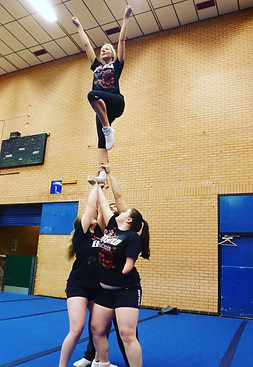
What is ParaCheer/Adaptive Abilities?

ParaCheer, known under the ICU as Adaptive Abilities until confirmation from the Paralympic committee, is part of the new group of inclusive cheerleading divisions available since it’s competitive debut at the ICU Cheerleading Worlds 2017. Adaptive Abilities Cheerleading incorporates most of the elements of a current cheerleading routine – jumps, dance, stunts and tumbling (this currently excludes Basket and Sponge Tosses). Teams can be either ‘Traditional’ meaning all athletes on the team have a disability, or ‘Unified’ meaning that there is a mix of disabled and non-disabled athletes working together. At the ICU World Championships, Unified Adaptive Abilities divisions require a minimum of 25% of the team to have some form of disability, though 50% disability inclusion is considered best practice. Local rules differ by competitions depending on the level of development in this category and can require only one disabled athlete, this is to help the sport grow.
There are currently 5 categories of the divisions at competitions,
-
Co-ed
-
All-girl
-
Freestyle Pom
-
Hip-hop
-
Group Stunt
For more information on those categories please see our page 'What is Cheerleading'. All existing cheerleading ‘safety regulations’ are valid in ParaCheer/Adaptive Abilities divisions. Additional rules and regulations have been added to manage the unique aspect of impairments and mobility aids involved during performance. There are some key elements in ParaCheer that differ from classical cheerleading, these include the idea of “base supports” and “Clear-away Cradles”. No baskets are allowed.


Taking part in ParaCheer teams and competition really supports disabled people by including them into activities previously difficult to access. It helps develop increased confidence and self-esteem, helping to relieve depression. It creates an enhanced sense of control over their physicality and in some cases greater strength and coordination, assisting the rest of their day-to-day lives. Cheerleading also specifically teaches performance, communication, and leadership skills. Leadership skills and communication are vital to enable people to get the assistance they need from carers, support workers, and the wider society.
For more on this please see our page 'Benefits of Inclusive Cheerleading'
How We Define Disability
The UK government says a person counts as disabled if they have;
“A severe impairment to a persons day to day activities which has lasted or is expected to last more than 9 months”
Here the word 'impairment' is used to define a persons medical diagnosis and how that effects their capabilities in their day to day life. The 9 months mark is to ensure that it’s only defining people with impairments that are long term, rather than an acute injury or something like pregnancy which impairs a persons day to day activities but isn't classe as a disability.
We feel that where a person’s impairment or self declared disability causes them difficulty in cheerleading on a classical team or means they are more comfortable working in an inclusive environment then that’s enough at present to “qualify” them for participation, especially at local and regional levels, to support the growth of the sport as a whole. Teams, Federations and Event producers are welcome to require further proof of disability for instance a doctors note, proof of government benefits etc if they feel that's necessary for parity.
To assist in growing the sport on a national level and to support the continuing mission to gain Paralympic status we are encouraging the creation of Tradition teams where every athlete has one of the impairments listed on the IPC’s Eligible Impairment Guidelines below. More information about these guidelines can be found on the IPC’s website.
-
Impaired muscle power
-
Impaired passive range of movement
-
Limb deficiency
-
Leg length difference
-
Short stature
6. Hypertonia
7. Ataxia
8. Athetosis
9. Visual Impairment
10. Intellectual Impairment
* Additionally although Hearing impairment isn’t classified under IPC guidelines it is currently in the ICU rules guidelines, since music is such an important part of the sport.
How is ParaCheer/Adaptive Abilities different to Special Olympics cheerleading/Special Abilities division?
There is sometimes confusion about the differences between Special Olympics, Special Abilities and Adaptive Abilities / ParaCheer, due to all being inclusive of disabled participants. The table below breaks down the differences.






